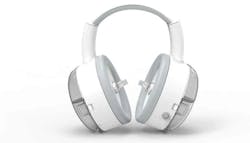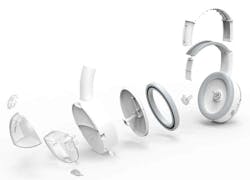If I said 12 million people visit the doctor every year for a very specific reason, you might picture broken arms or the flu. What you might not think about is earwax. Nevertheless, every year more than 12 million Americans visit their physicians for impacted earwax removal. And little wonder: When enough earwax accumulates in the earl canal, it can cause symptoms such as pain, fullness, itching, odor, tinnitus, discharge, coughing, and hearing loss.
While no doubt an unpleasant condition to contemplate, Tucson-based startup, SafKan, the latest Protolabs Cool Idea! Award winner, is doing something to address it: The company is introducing OtoSet, a pair of headphones that can professionally clean a patient’s ear in just 35 sec. The headphones have disposable silicone nozzles that spray a warm saline solution against the walls of the ear canal while extracting the solution and wax back into the nozzles and disposable outflow containers, avoiding messy spills. SafKan eventually plans to roll out a consumer version of the device, but for now OtoSet is to be administered by healthcare providers.
The Ear & Bladder Syringe has been the standard of care since 1821, but it can be frustrating for physicians to use and painful for patients. The Diwan brothers knew they had a better solution. Leaning on Protolabs’ expertise in Polyjet 3D printing and CNC machining, they are using 14 unique parts from the digital manufacturer. Once made, the parts for multiple devices were shipped to Tucson, Ariz., where they are assembled and tested by SafKan.
“It’s pretty easy to design headphones on your computer and 3D print it,” said co-founder Sahil Diwan. “But then you need to take that to the next level and start to commercialize it. Protolabs has been really helpful with our engineering team, using experience that we don’t have in-house to get our device ready to go to market.”
OtoSet went through several iterations, made possible by the team at Protolabs. SafKan relied on the Cool Idea! Award grant to remove the financial burden from clinical trials to quickly place working prototypes into the hands of physicians.
“Without this grant, it would take more time,” said Sahil. “This allows us to build these devices, have them be the real deal, and get them to physicians quickly.”
Since completing two clinical trials, OtoSet is slated to be introduced in a beta program in several cities, including Seattle, San Francisco, Los Angeles, Tucson, Houston, and Philadelphia. With funding from the Cool Idea! Award, SafKan has developed industrial-grade prototypes that are now being tested by more than 50 physicians across the country.
“One of the largest segments we serve as a digital manufacturing company is the medical and health care industry,” said Protolabs President and CEO Vicki Holt. “So when the opportunity comes to support amazing products like OtoSet—devices that are solving real problems for its users—I’m more than thrilled with the fact that we can provide a manufacturing grant to do that.” In the future, SafKan plans to make the product available to consumers so that the millions of Americans who typically visit their physicians for ear syringing no longer have to.
Brilliant ideas for new products emerge every day, but far too many promising napkin sketches end up in wastebaskets because product development resources are scarce. The Protolabs Cool Idea! Award was created to help turn those inspiring concepts into real-life products. Each year, the program awards an aggregate of up to $250,000 in Protolabs manufacturing services to innovative thinkers who can use their grant towards building prototypes or even an initial production run. This award has been going on for years. Check out some of the past Cool Idea! Award Winners.



